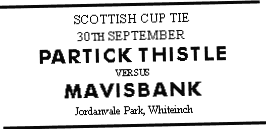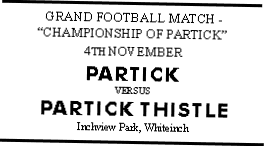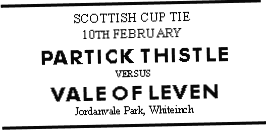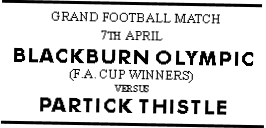1882-83 Local Domination
-
Challenge matches against English FA Cup winners
-
Three times winners of the Yoker Cup
-
Scottish Cup quarter finals reached
The new season dawned in mid-August with the new Committee already in place, elected in the AGM at the end of the previous season as follows :
- Hon. President Alex. McGeoch
- President John Burleigh
- Vice President W.McCall
- 1st XI Captain John Beattie
- 1st XI Vice Captain G.Leckie
- 2nd XI Captain W.Stirling
- 2nd XI Vice Captain A.Young
- Treasurer John Weir
- Hon. Secretary Alex Rose
- Match Secretary A.Cameron
Following his close call to representative honours, Andrew Duff stood down as Vice President to concentrate on his playing. Indeed the goalkeeper receive high praise when he was listed in the SFA Annual of 1882 as one of the top Scottish players :
“DUFF A. Partick Thistle.
Goalkeeper of the highest promise; very smart.”
The season proper started with a visit to Greenock for the opening game of Morton’s season, and despite the scoring feats of the previous season, captain Beattie tried out several new forwards including T.Patterson and Jerry Suter, who were amongst the goals, the game finishing 3-1 in Thistle’s favour.
Thistle remained away from home in Renfrewshire for the first game of September with a visit to Renfrew. Playing ten men a side the game finished 1-1.
After the lengthy Scottish Cup run of the preceding season there was great excitement for the competition this year, and in the first round Thistle were drawn to play Battlefield of Langside at Overdale Park. With only 18 minutes to go the south-side team looked to have eliminated Thistle, but a headed goal from John Young began the fightback. John Beattie scored an equaliser, before Patterson and Paton scored to win the game for Thistle in the dying minutes.
It was the end of September before the opening game at Jordanvale was played, Whitefield were the visitors, and the home side had a comfortable 5-0 win, new forward Patterson in particular was impressive.
There was little doubt that interest in football in Partick was at a high, and previous Thistle rivals Mavisbank and Pilgrims were excited when they drew Partick Thistle and Partick respectively in the second round of the Scottish Cup. Both teams decided to switch their games to the away grounds to take advantage of the football mania. The results of the games proved that both clubs were perhaps correct to take advantage of getting a quick buck, but neither was successful in footballing terms. Partick defeated Pilgrims 2-1 but Mavisbank were even less fortunate. 
The Govan side had been defeated 3-1 by Thistle the previous season in the cup, but this season they were outclassed and sent back across the river with a 14-2 hiding. Indeed it could have been many more, Thistle leading 10-0 at half-time and taking things easy in the second half.
Despite a 3-4 defeat by Beith in an away match, Thistle again came to the attention of the press when the Scottish Athletic Journal described the club as “that rising junior club”.
Cambuslang seemed aware of the reputation of Thistle, and they began the Scottish Cup tie between the clubs impressively, and reached half-time 2-0 up. After the break the home side scored again to leave Thistle again facing a cup exit. Again they left things until the last minutes before magnificent play from captain Beattie saw him beat four men before scoring while “Paton and Beaton attended to the keeper”. Paton and Suter scored in the final minute to secure a replay at Jordanvale the following weekend.
The Scottish Athletic Journal stated that Thistle were “almost invincible on their own ground”, and the home record continued the following week, although Cambuslang would not be beaten. Thistle were again behind at half-time, 1-3, with Stirling debuting in goal and Beaton scoring for Thistle. In the second half the Thistle forwards had most of the play but were only able to score twice through John Young and Ewing. John Beattie continued his excellent form at half back – he “could not have been excelled”. With scores level after a second game, both clubs were allowed through to the next round. Thistle were drawn to play against Glasgow University in the fourth round.
Although the Scottish Cup generated huge interest in its matches, the contest that grabbed the imagination in Partick was the first meeting of the season between Thistle and local rivals Partick. An immense crowd was expected at Inchview and the match was previewed :
“Few have any conception of the rivalry which exists between these clubs, and the excitement which is raised in the fashionable suburb whenever a game between them is on the tapis.”

There was a large and often noisy crowd including a number of ladies, and they didn’t have to wait for long before Thistle took the lead through Ewing, and then with a second goal from Suter. Despite much of the play in the second period the Thistle forwards were erratic and should have scored more than the third and final goal of the game scored by Patterson. Thistle again played a new goalkeeper – Eadie played a fine game. The match finished 3-1 to Thistle.
The Scottish Athletic Journal were moved to comment “The Thistle is cock of the walk in Partick at present, having leathered the Partick by 3-1, while Athletic News crowned Thistle “Champions of Partick”.
Not everyone in Partick was happy with the change in the balance of power in the burgh – the Scottish Athletic Journal received a letter from a member of Partick FC. According to the letter the referee disallowed a Partick goal, then allowed an offside goal by Thistle. The score should have been 2-2. The letter ended
“If the Thistle won, it was certainly not by superior play, but through the favour of the referee”.
Later in the month, the same paper reported receipt of several letters exonerating the referee in the derby match, including one from the Partick secretary no less. A case of sour grapes seemed to have been closed.
The game against Partick continued Thistle’s remarkable home form, undefeated at their Jordanvale ground since moving their from the public Overnewton, a period of more than two years. However, the following week saw the visit of arguably the finest football side yet at Whiteinch. Vale of Leven – previous winners of the Scottish Cup – were the visitors. A lesson in how much still had to be done was received from the team from Dumbartonshire, along with a 1-6 defeat (although some reports gave the score as 2-6), and the fall of the proud home record.
The dedicated sports newspaper the Scottish Athletic Journal had improved coverage of all levels of Scottish sport, and again they commented on Thistle’s progress, and again on the local rivalry :
“At last the spell is broken; the Partick Thistle have actually been beaten on their own ground. No doubt the Partick will be jubilant. The Thistle have a capital team, their only weakpoint is their goalkeeper. They have tried two or three in the position, but none of the probationers have proved adept at the business. Hunt up that goalkeeper Mr Rose.”
Glasgow University scratched from the Scottish Cup fourth round tie, and Thistle went into the draw for the next round, receiving a bye straight into the sixth round.
A first visit to the capital was next for Thistle as they travelled to play Hibernians in front of very few spectators. The game ended in a 0-2 defeat for Thistle, but the team were reluctant to acknowledge more than a single-goal defeat. The visitors stated that the other goal was undoubtedly offside, and pointed to different interpretations of the offside law by Glasgow and Edinburgh referees.
November saw a further development at the club when membership of the 2nd XI Association was attained, and the following month the first tie in the 2nd XI Cup was played – resulting in defeat for Thistle by 2-0 at the feet of Third Lanark.
The festive period was traditionally been a time for glamorous challenge matches and this season Partick Thistle had arranged a return match against Blackburn Olympic after the 4-4 draw the previous season. However, the SFA ordered that all Scottish Cup sixth round ties were to be played by the 1st of January. Vale of Leven had won their fifth round match to be paired with Thistle, and they were also facing cancellation of their challenge matches. The two clubs, along with others such as Queen’s Park and Dumbarton, were at odds with the SFA and Thistle in particular were “feeling disposed to ignore the (SFA) committee and carry out their fixture on Saturday at Partick against Blackburn Olympic”. With the weight of Queen’s Park and the others the SFA agreed to delay the deadlines, and Thistle extended their Scottish Cup campaign past the turn of the year for the first time.
The match against Blackburn Olympic went ahead at Jordanvale, Olympic fielding players from their more famous neighbours Blackburn Rovers. Thistle had most of the play but the English keeper saved numerous chances to help his side win the game 2-0. An interesting experiment was carried out in the game – the first half saw English-style throw-ins (one-handed, any direction), while the second used Scottish throw-ins.
The Athletic News were disappointed with some of the conditions the visitors had to put up with at Jordanvale.
“… their great victory is all the more creditable when we remember the sort of field the game was played on. It is all ridges, and few clubs who visit it leave it victorious. I had a conversation with a friend who was present, and he tells me the spectators did not behave very gentlemanly towards the strangers, which I regret very much, as when Scotchmen visit Lancashire and especially Blackburn, they are always cordially received. The Thistle players were in no way to blame for this – they took their defeat like brave men, determining to do better the next time they meet the Olympians.”
The New Year holiday saw Thistle take the road to Dundee to play two local teams – Strathmore and Our Boys, winning both games 10-0 and 6-0 respectively, before returning home to play a home game against Abercorn (2-2) and an away match against Rangers (0-3) prior to the long-awaited Scottish Cup tie against Vale of Leven. 
2,000 spectators packed into Jordanvale to see if Thistle could reverse the 1-6 defeat from the Dumbartonshire club of earlier in the season and qualify for the semi-finals, but it was not a good day for Thistle. Andrew Duff was back in goals but he was powerless as Vale won 4-0 to progress in the tournament. Vale were to reach the final where they lost to Dumbarton.
Hibernians travelled through to Glasgow for the return match and won 3-2 – it appeared that fortress Jordanvale was no more. Another friendly followed against Falkirk where Thistle only arrived with six players. Substitutes had to be found at the ground, and it was no surprise that Falkirk won the game by 6-2.
Thistle’s favourite local cup competition, the Yoker Challenge Cup began in March, and the holders had a match against host club Yoker which Thistle won 2-1. However, the second Thistle goal was deflected by an arm which the referee did not see, and the game had to be replayed. The replay saw Thistle in determined mood, and Yoker were no match for the quick Thistle forwards and resolute defenders. The game finished 6-0 to Thistle.
The final of the Yoker Challenge Cup quickly followed, with Thistle, as two-time winners of the trophy, the favourites against Sir John Maxwell, a team from Pollokshaws. Thistle’s team was : Duff, Brown, Hendry, Beattie, Leckie, Erskine, Ewing, Young, Patterson, Suter, Beaton.
“YOKER CUP FINAL – PARTICK THISTLE v SIR JOHN MAXWELL
At Yoker, and resulted in a win for the Partick Thistle by two goals to one disallowed to none. In the first half the game was pretty even but neither team scored. In the second half the Thistle completely hemmed in the Sir John, but owing to the gusty wind, only scored thrice – one being disallowed. The Sir John only crossed the centre of the field once in this half. The Thistle now having won this cup three years in succession, it becomes their property.”
Also in March moves were afoot off the field to reorganise Scottish football. Representatives of the Glasgow clubs agreed to form the Glasgow Football Association to allow the GFA to organise Glasgow Select matches. This would allow the SFA to concentrate on national affairs and allow regional associations to affiliate to the SFA. Partick Thistle were elected to a position on the committee along with ten other Glasgow clubs.
Vale of Leven recognised the worth of Partick Thistle by inviting them to a match at Alexandria a week prior to their Scottish Cup Final appearance to give them a vigorous challenge. Thistle scored within the first minute and for some time looked as if they might get their first victory over the senior side. However, an improved second half performance took Vale through by 4-1.
 Blackburn Olympic had just won the English Cup, and to celebrate they invited their old friends from Glasgow back down to Lancashire for their first match as Cup holders. The English side won 3-0.
Blackburn Olympic had just won the English Cup, and to celebrate they invited their old friends from Glasgow back down to Lancashire for their first match as Cup holders. The English side won 3-0.
Thistle had gone through a poor spell of results since defeat in the Scottish Cup, but they got back to winning ways after a match with Rangers at Jordanvale. Thistle gave chances to two 2nd XI players, and played the game using just five forwards instead of the usual six, dropping one forward back to half-back to create the classic 2-3-5 formation which lasted for a long time. Thistle benefited from the change and won the game 2-0.
Another home defeat, this time 1-2 to Morton, preceded the last game of the season – a home game against Partick at Jordanvale. Partick prepared well for this contentious match, drafting in guests from Bolton and Ayr to strengthen their side. Thistle dominated the second half and emerged victorious from the game by 2-0, with goals from Beaton and Suter.
Categories
- Miscellaneous (16)
- Other clubs (15)
- Players (26)
- Thistle – early years (48)
- Thistle – general (5)
Football history links
- Ayr United archive
- Bill Shankly
- Falkirk Historian
- Gallant Pioneers – Early history of Rangers
- Glasgow Herald archive at Google
- Hibernian
- Hibernian Historical Trust
- London Hearts
- Partick Thistle history archive by StuTheJag
- Rangers History
- Scottish Football Historical Archive
- Scottish Football Museum
- Scottish Sports History
- ScottishLeague.net and forum
